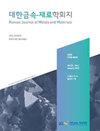Influence of Elevated Temperature on the Mechanical and Microstructural Properties of Glass Fiber-Reinforced Polymers
IF 1.1
4区 材料科学
Q4 MATERIALS SCIENCE, MULTIDISCIPLINARY
引用次数: 0
Abstract
Glass fiber-reinforced polymers (GFRPs) have attracted significant attention as structural materials because of their high fatigue resistance, corrosion resistance, strength, and stiffness. This study examined the effect of elevated temperatures (150, 250, 350, and 450oC) on the microstructural and mechanical properties of GFRP plates. The number of bubbles increased as the firing temperature increased, and the bubbles burst at 250oC or higher, forming pores on the surface. A tensile test was conducted, and the maximum stress of the GFRP plates fired at 150, 250, and 350oC was reduced from 54.2 to 52.2, 40.3, and 24.0 MPa, respectively, compared to that of the unfired GFRP plate. Meanwhile, the elastic moduli of the GFRP plates fired at 150, 250, and 350oC reduced from 19.1 to 18.3, 16.1, and 12.1 GPa, respectively, compared to that of the unfired GFRP plate. This reduction in the mechanical properties of the GFRP plates at elevated temperatures was attributed to the degradation of the mechanical properties of the resin matrix due to glass transition and decomposition, debonding, and an increase in surface defects. The maximum strain decreased gradually with increasing firing temperature, suggesting that the brittleness of the GFRP plates increased at elevated temperatures.高温对玻璃纤维增强聚合物力学和显微组织性能的影响
玻璃纤维增强聚合物(gfrp)作为一种结构材料,因其具有较高的抗疲劳、耐腐蚀、强度和刚度而备受关注。本研究考察了高温(150、250、350和450℃)对玻璃钢板材微观结构和力学性能的影响。气泡数量随着烧成温度的升高而增加,在250℃及以上时气泡破裂,在表面形成气孔。拉伸试验结果表明,与未烧制GFRP板相比,GFRP板在150、250和350℃下的最大应力分别从54.2 MPa降低到52.2 MPa、40.3 MPa和24.0 MPa。与此同时,GFRP板在150、250和350℃下的弹性模量分别从19.1降低到18.3、16.1和12.1 GPa。GFRP板在高温下机械性能的降低是由于树脂基体的机械性能的退化,这是由于玻璃化转变和分解、脱粘以及表面缺陷的增加。随着烧成温度的升高,最大应变逐渐减小,表明GFRP板的脆性在高温下增加。
本文章由计算机程序翻译,如有差异,请以英文原文为准。
求助全文
约1分钟内获得全文
求助全文
来源期刊

Korean Journal of Metals and Materials
MATERIALS SCIENCE, MULTIDISCIPLINARY-METALLURGY & METALLURGICAL ENGINEERING
CiteScore
1.80
自引率
58.30%
发文量
100
审稿时长
4-8 weeks
期刊介绍:
The Korean Journal of Metals and Materials is a representative Korean-language journal of the Korean Institute of Metals and Materials (KIM); it publishes domestic and foreign academic papers related to metals and materials, in abroad range of fields from metals and materials to nano-materials, biomaterials, functional materials, energy materials, and new materials, and its official ISO designation is Korean J. Met. Mater.
 求助内容:
求助内容: 应助结果提醒方式:
应助结果提醒方式:


